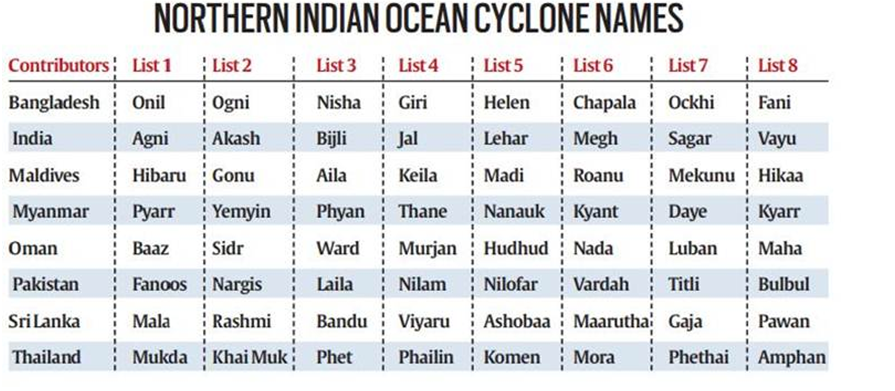

- The recent cyclone to emerge out of the Bay of Bengal has been named Fani. It has made landfall in Odisha causing the most destruction in 2 cities- Puri and Bhubhneshwar.
- Before this, there were cyclones Hudhud in 2014, Ockhi in 2017 and Titli and Gaja in 2018.
- The first cyclone after the list was adopted was given the name in the first row of the first column — Onil, proposed by Bangladesh. The next cyclone will have name- Vayu.
Context
- The recent cyclone to emerge out of the Bay of Bengal has been named Fani. It has made landfall in Odisha causing the most destruction in 2 cities- Puri and Bhubhneshwar.
- Before this, there were cyclones Hudhud in 2014, Ockhi in 2017 and Titli and Gaja in 2018.
- The first cyclone after the list was adopted was given the name in the first row of the first column — Onil, proposed by Bangladesh. The next cyclone will have name- Vayu.
About
Naming of cyclones:
- Each Tropical Cyclone basin in the world has its own rotating list of names.
- For cyclones in the Bay of Bengal and Arabian Sea, the naming system was agreed by eight member countries of a group called WMO/ESCAP and took effect in 2004.
- These eight countries are – Bangladesh, India, Maldives, Myanmar, Oman, Pakistan, Sri Lanka and Thailand.
- The first cyclone after the list was adopted was given the name in the first row of the first column — Onil, proposed by Bangladesh.
- Subsequent cyclones are being named sequentially, column-wise, with each cyclone given the name immediately below that of the previous cyclone.
- Once the bottom of the column is reached, the sequence moves to the top of the next column.
- So far, the first seven columns have been exhausted, and Fani (again proposed by Bangladesh) is the top name in the last column.
- The next cyclone will be named Vayu. When all the names in list are exhausted, the eight countries will propose fresh lists of names.
- The lists for storms in the Atlantic and Eastern Pacific basins are, however, rotated when the names in the list get exhausted. Exception are, however, made in certain cases — if a storm causes excessive death and destruction, its name is considered for retirement and is not repeated; it is replaced with another name.
Why naming of cyclones is done?
- Appending names to cyclones makes it easier for the media to report on these cyclones, heightens interest in warnings, and increases community preparedness.
- Names are easier to remember than numbers and technical terms and hence can reach greater masses.
- If public wants to suggest the name of a cyclone to be included in the list, the proposed name must meet some fundamental criteria. The name should be short and readily understood when broadcast. Further, the names must not be culturally sensitive and should not convey any unintended and potentially inflammatory meaning.



